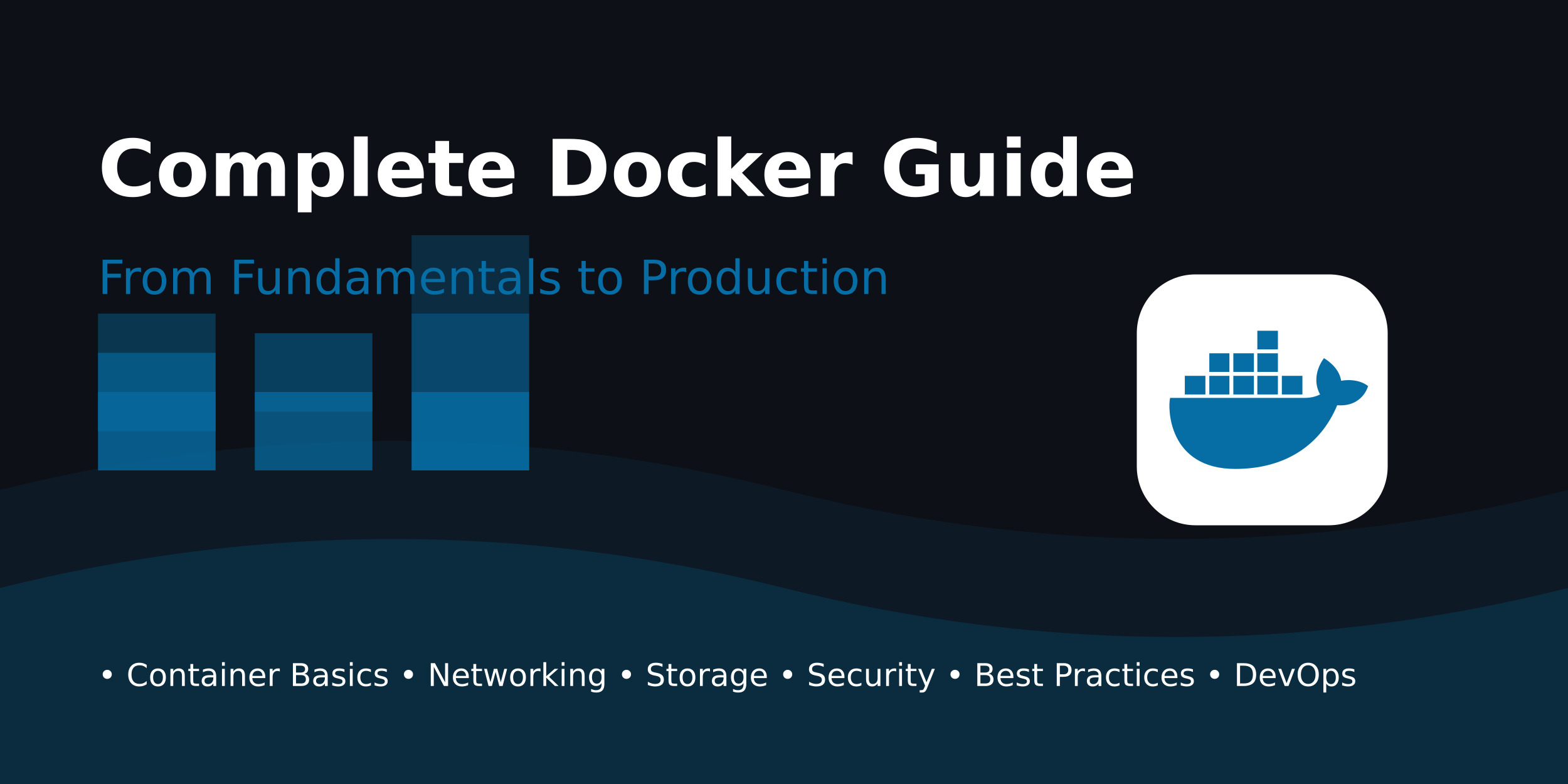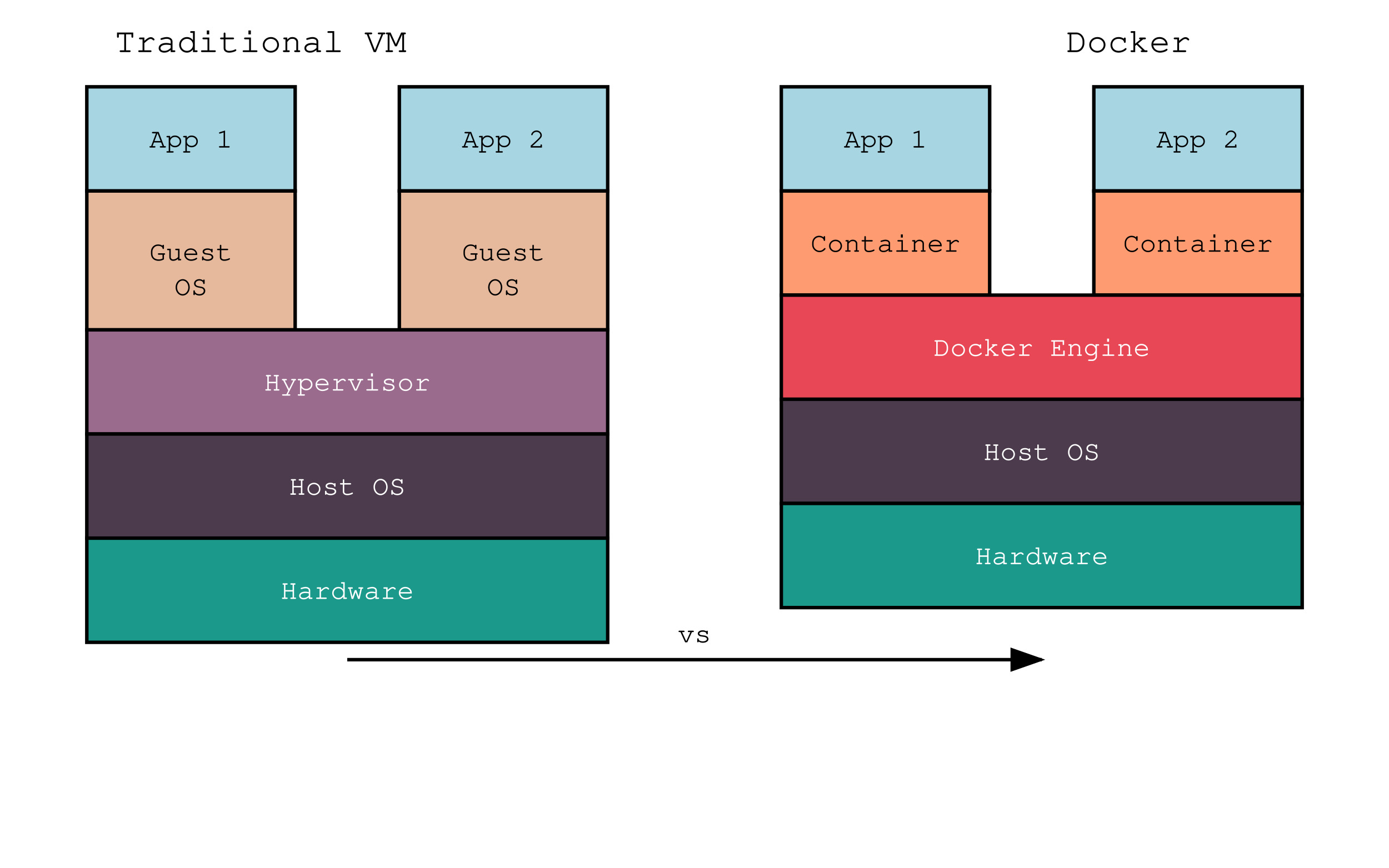Complete Docker Guide: From Fundamentals to Production
 Kanav Gathe
Kanav Gathe
1. Introduction to Docker
What is Docker?
Docker is a platform for developing, shipping, and running applications in containers. Containers are lightweight, standalone, executable packages that include everything needed to run an application: code, runtime, system tools, libraries, and settings.
Why Docker?
Consistency: Same environment across development, testing, and production
Isolation: Applications run independently without conflicts
Portability: Run anywhere that supports Docker
Resource Efficiency: Lighter than traditional VMs
Scalability: Easy to scale applications horizontally
Version Control: Track changes in your application environment
Real-World Use Cases
Microservices architecture
Continuous Integration/Continuous Deployment (CI/CD)
Cloud-native applications
Development environments
Application testing
Legacy application modernization
2. Docker Architecture
Core Components
Docker Daemon
Manages Docker objects
Handles container lifecycle
Maintains images, networks, and volumes
Docker Client
Command-line interface
Communicates with Docker daemon via REST API
Can connect to remote Docker daemons
Docker Registry
Stores Docker images
Docker Hub (public registry)
Private registries
Container vs VM Architecture

3. Installation and Setup
Linux Installation
# Update package index
sudo apt-get update
# Install prerequisites
sudo apt-get install \
apt-transport-https \
ca-certificates \
curl \
gnupg \
lsb-release
# Add Docker's official GPG key
curl -fsSL https://download.docker.com/linux/ubuntu/gpg | sudo gpg --dearmor -o /usr/share/keyrings/docker-archive-keyring.gpg
# Set up stable repository
echo "deb [arch=amd64 signed-by=/usr/share/keyrings/docker-archive-keyring.gpg] https://download.docker.com/linux/ubuntu $(lsb_release -cs) stable" | sudo tee /etc/apt/sources.list.d/docker.list > /dev/null
# Install Docker Engine
sudo apt-get update
sudo apt-get install docker-ce docker-ce-cli containerd.io
# Verify installation
sudo docker run hello-world
Windows Installation
Download Docker Desktop for Windows from the official website
Run the installer
Enable WSL 2 (Windows Subsystem for Linux)
Configure resources in Docker Desktop
Test installation:
docker version
docker run hello-world
Post-installation Steps
# Add user to docker group (Linux)
sudo usermod -aG docker $USER
# Configure Docker to start on boot
sudo systemctl enable docker
# Configure Docker daemon
sudo nano /etc/docker/daemon.json
{
"log-driver": "json-file",
"log-opts": {
"max-size": "10m",
"max-file": "3"
}
}
4. Docker Core Concepts
Images
Definition: Read-only templates for containers
Layers: Each instruction in Dockerfile creates a layer
Commands:
# List images
docker images
# Pull image
docker pull nginx:latest
# Remove image
docker rmi nginx:latest
# Build image
docker build -t myapp:1.0 .
# Tag image
docker tag myapp:1.0 username/myapp:1.0
# Push image
docker push username/myapp:1.0
Containers
Definition: Running instances of Docker images
Lifecycle: Created → Running → Stopped → Deleted
Commands:
# Run container
docker run -d -p 80:80 nginx
# List containers
docker ps
docker ps -a # Including stopped containers
# Stop container
docker stop container_id
# Start container
docker start container_id
# Remove container
docker rm container_id
# Execute command in container
docker exec -it container_id bash
Registries
Types:
Public (Docker Hub)
Private (Amazon ECR, Google Container Registry)
Self-hosted (Docker Registry)
Authentication:
# Login to registry
docker login
# Push to registry
docker push username/image:tag
# Pull from registry
docker pull username/image:tag
5. Networking
Network Types
Bridge: Default network driver
Isolated network on host
Containers can communicate
Port mapping for external access
Host: Removes network isolation
Uses host's network directly
Better performance
Less security isolation
None: Disables networking
Complete network isolation
Used for maximum security
Overlay: Multi-host networking
Connect containers across hosts
Used in Docker Swarm
Network Commands
# List networks
docker network ls
# Create network
docker network create mynetwork
# Connect container to network
docker network connect mynetwork container_id
# Disconnect container from network
docker network disconnect mynetwork container_id
# Inspect network
docker network inspect mynetwork
# Remove network
docker network rm mynetwork
Network Configuration Example
# Create custom network with specific subnet
docker network create \
--driver bridge \
--subnet 172.18.0.0/16 \
--gateway 172.18.0.1 \
mynetwork
# Run container with specific IP
docker run -d \
--network mynetwork \
--ip 172.18.0.10 \
nginx
6. Volumes and Storage
Types of Storage
Volumes: Managed by Docker
Best practice for persistent data
Easy backup and migration
Can be shared between containers
Bind Mounts: Direct host filesystem mounting
Good for development
Host-dependent
Can affect performance
tmpfs: Memory-only storage
Temporary storage
High performance
Data lost on container stop
Volume Commands
# Create volume
docker volume create myvolume
# List volumes
docker volume ls
# Inspect volume
docker volume inspect myvolume
# Remove volume
docker volume rm myvolume
# Remove unused volumes
docker volume prune
Volume Usage Examples
# Run container with volume
docker run -d \
-v myvolume:/data \
nginx
# Run container with bind mount
docker run -d \
-v /host/path:/container/path \
nginx
# Run container with tmpfs
docker run -d \
--tmpfs /tmp:rw,noexec,nosuid,size=100m \
nginx
7. Dockerfile Deep Dive
Basic Structure
# Base image
FROM node:16-alpine
# Set working directory
WORKDIR /app
# Copy package files
COPY package*.json ./
# Install dependencies
RUN npm install
# Copy source code
COPY . .
# Build application
RUN npm run build
# Expose port
EXPOSE 3000
# Set environment variables
ENV NODE_ENV=production
# Define entry point
CMD ["npm", "start"]
Advanced Dockerfile Concepts
Multi-stage Builds
# Build stage
FROM node:16-alpine AS builder
WORKDIR /app
COPY package*.json ./
RUN npm install
COPY . .
RUN npm run build
# Production stage
FROM node:16-alpine
WORKDIR /app
COPY --from=builder /app/dist ./dist
COPY package*.json ./
RUN npm install --production
CMD ["npm", "start"]
Build Arguments
ARG NODE_VERSION=16
FROM node:${NODE_VERSION}-alpine
ARG PORT=3000
ENV PORT=${PORT}
EXPOSE ${PORT}
Health Checks
HEALTHCHECK --interval=30s --timeout=3s \
CMD curl -f http://localhost:3000/health || exit 1
A Dockerfile is a script containing instructions to build a Docker image. The basic structure starts with a base image (FROM), sets up a working directory (WORKDIR), and then follows a pattern of copying files and running commands to set up the application. The example shows a Node.js application setup, where it first copies package files, installs dependencies, copies source code, builds the app, exposes a port, sets environment variables, and defines how to start the application.
The advanced concepts demonstrate multi-stage builds, which use multiple FROM instructions to create a smaller production image by building in one stage and copying only necessary files to the final stage. This is particularly useful for reducing image size by excluding build tools and dependencies from the final image. Build arguments (ARG) allow for flexibility during image building by passing variables that can be used in the Dockerfile. Health checks are used to monitor container health by periodically running commands to verify the application is working correctly.
These Dockerfile patterns are essential for creating efficient, secure, and production-ready container images while maintaining development flexibility and monitoring capabilities.
8. Docker Compose
Basic Structure
version: '3.8'
services:
web:
build: ./web
ports:
- "3000:3000"
environment:
- NODE_ENV=production
depends_on:
- db
networks:
- mynetwork
db:
image: postgres:13
volumes:
- db-data:/var/lib/postgresql/data
environment:
- POSTGRES_PASSWORD=secret
networks:
- mynetwork
networks:
mynetwork:
volumes:
db-data:
Commands
# Start services
docker-compose up -d
# Stop services
docker-compose down
# View logs
docker-compose logs -f
# Scale service
docker-compose up -d --scale web=3
# Execute command in service
docker-compose exec web npm run test
# View service status
docker-compose ps
Advanced Compose Features
version: '3.8'
services:
web:
build:
context: ./web
dockerfile: Dockerfile.prod
args:
- NODE_VERSION=16
deploy:
replicas: 3
resources:
limits:
cpus: '0.5'
memory: 512M
healthcheck:
test: ["CMD", "curl", "-f", "http://localhost:3000/health"]
interval: 30s
timeout: 3s
retries: 3
Docker Compose is a tool for defining and running multi-container applications. The basic structure uses YAML format to define services, networks, and volumes. In the example, it sets up two services: a web application and a PostgreSQL database. Each service has its own configuration, including build instructions, port mappings, environment variables, dependencies (depends_on), and network settings. The services are connected through a custom network (mynetwork) and the database uses a named volume (db-data) for data persistence.
Common Docker Compose commands allow you to manage your multi-container application: 'up' starts services, 'down' stops them, 'logs' shows output, and 'scale' adjusts the number of containers for a service. The advanced features showcase deployment configurations with resource limits (CPU and memory), health checks for monitoring service health, and build arguments for flexible image building. This makes Docker Compose powerful for both development and production environments, handling everything from simple two-service setups to complex microservice architectures with multiple interconnected containers.
This setup demonstrates how Docker Compose simplifies container orchestration, making it easier to manage multiple containers as a single application while providing robust features for scaling, monitoring, and resource management.
9. Security
Container Security
Image Security
Use official base images
Scan for vulnerabilities
Keep images updated
Runtime Security
Run as non-root user
Use read-only root filesystem
Limit capabilities
Network Security
Use user-defined networks
Implement network policies
Control exposed ports
Security Best Practices
# Use specific version
FROM node:16-alpine
# Create non-root user
RUN addgroup -S appgroup && adduser -S appuser -G appgroup
# Set working directory
WORKDIR /app
# Copy and install dependencies
COPY package*.json ./
RUN npm ci --only=production
# Copy application code
COPY --chown=appuser:appgroup . .
# Use non-root user
USER appuser
# Run application
CMD ["npm", "start"]
Security Configuration
version: '3.8'
services:
web:
security_opt:
- no-new-privileges:true
read_only: true
tmpfs:
- /tmp
cap_drop:
- ALL
cap_add:
- NET_BIND_SERVICE
10. Troubleshooting
Common Issues and Solutions
- Container Won't Start
# Check logs
docker logs container_id
# Inspect container
docker inspect container_id
# Check resource usage
docker stats
- Network Issues
# Check network connectivity
docker network inspect network_name
# Test container networking
docker exec container_id ping other_container
# View container IP
docker inspect -f '{{range .NetworkSettings.Networks}}{{.IPAddress}}{{end}}' container_id
- Volume Issues
# Check volume mounts
docker inspect -f '{{ .Mounts }}' container_id
# Verify permissions
docker exec container_id ls -la /path/to/volume
# Check volume data
docker volume inspect volume_name
Debugging Tools
# Interactive shell
docker exec -it container_id sh
# Process list
docker top container_id
# Resource usage
docker stats container_id
# System events
docker events
11. Best Practices
Image Building
- Use .dockerignore
node_modules
npm-debug.log
Dockerfile
.dockerignore
.git
.gitignore
- Layer Optimization
# Bad
COPY . /app
RUN npm install
# Good
COPY package*.json /app/
RUN npm install
COPY . /app
- Multi-stage Builds
# Build stage
FROM node:16-alpine AS builder
WORKDIR /app
COPY package*.json ./
RUN npm install
COPY . .
RUN npm run build
# Production stage
FROM nginx:alpine
COPY --from=builder /app/build /usr/share/nginx/html
Container Management
- Resource Limits
docker run -d \
--memory="512m" \
--cpus="0.5" \
nginx
- Logging
# JSON logging configuration
{
"log-driver": "json-file",
"log-opts": {
"max-size": "10m",
"max-file": "3"
}
}
- Health Checks
healthcheck:
test: ["CMD", "curl", "-f", "http://localhost/health"]
interval: 30s
timeout: 10s
retries: 3
start_period: 40s
[Previous sections remain the same...]
12. Hands-on Project: Task Manager
Project Overview
A Flask-based task management application with:
Backend: Python/Flask
Database: MongoDB
Docker Compose for orchestration
Volume persistence for data
Network isolation
Project Repository
The complete source code is available at: https://github.com/SlayerK15/Task-Manager
Implementation Details
Directory Structure
task-manager/
├── template/index.html
├── docker-compose.yml
├── Dockerfile
├── app.py
├── requirements.txt
└── README.md
Dockerfile Analysis
FROM python:3.9-slim
WORKDIR /app
COPY requirements.txt .
RUN pip install --no-cache-dir -r requirements.txt
COPY . .
EXPOSE 5000
CMD ["python", "app.py"]
Key points:
Uses Python 3.9 slim base image for smaller size
Sets up working directory
Installs dependencies first (layer caching)
Copies application code
Exposes port 5000
Uses simple Python command to run the app
Docker Compose Configuration
version: '3.8'
services:
web:
build:
context: .
dockerfile: Dockerfile
ports:
- "0.0.0.0:5000:5000"
environment:
- FLASK_APP=app.py
- FLASK_ENV=development
- MONGO_URI=mongodb://mongodb:27017/taskmanager
volumes:
- .:/app
depends_on:
- mongodb
networks:
- app-network
restart: unless-stopped
mongodb:
image: mongo:latest
ports:
- "127.0.0.1:27017:27017"
volumes:
- mongodb_data:/data/db
networks:
- app-network
restart: unless-stopped
networks:
app-network:
driver: bridge
volumes:
mongodb_data:
Key features:
Services:
Web service (Flask application)
MongoDB service (Database)
Environment Configuration:
Flask environment settings
MongoDB connection URI
Development mode enabled
Networking:
Custom bridge network (app-network)
Internal service discovery
Port mappings for both services
Persistence:
Volume mounting for application code
Named volume for MongoDB data
Data persistence across container restarts
Dependencies:
Web service depends on MongoDB
Proper startup order ensured
Restart Policies:
Both services restart unless stopped
Ensures high availability
Running the Project
- Clone the repository:
git clone https://github.com/SlayerK15/Task-Manager
cd Task-Manager
- Build and start the services:
docker-compose up --build
Access the application:
Web interface: http://localhost:5000
MongoDB (local access): localhost:27017
Stop the services:
docker-compose down
Development Workflow
Local Development:
Code changes reflect immediately due to volume mounting
No need to rebuild for Python file changes
Hot-reloading enabled in development mode
Database Management:
MongoDB data persists in named volume
Access database directly through exposed port
Use MongoDB compass or CLI tools
Troubleshooting:
# View logs
docker-compose logs -f
# Check service status
docker-compose ps
# Access container shell
docker-compose exec web bash
docker-compose exec mongodb mongo
Project Management:
Use docker-compose commands for service control
Easy environment variable configuration
Network isolation for security
This implementation demonstrates:
Proper Docker best practices
Service orchestration with Docker Compose
Development environment setup
Database integration
Volume management
Network configuration
Container security considerations
Connect & Learn More
Stay Connected
GitHub Repository: https://github.com/SlayerK15/Task-Manager
Star the repo if you found it helpful!
Feel free to fork and contribute
Report issues or suggest improvements
Watch for updates and new features
LinkedIn: www.linkedin.com/in/gathekanav
Connect for more tech content
Discussions on Docker, DevOps, and cloud technologies
Professional networking opportunities
Updates on new projects and tutorials
Share & Contribute
Share this guide with your network
Drop a star on GitHub if you found it helpful
Feel free to fork the project and make it your own
Issues and pull requests are welcome!
Thank you for following along with this comprehensive Docker guide! If you found it helpful, please consider:
Following on GitHub and LinkedIn
Sharing with others who might benefit
Contributing to make it even better
Let's learn and grow together! 🚀
Subscribe to my newsletter
Read articles from Kanav Gathe directly inside your inbox. Subscribe to the newsletter, and don't miss out.
Written by
